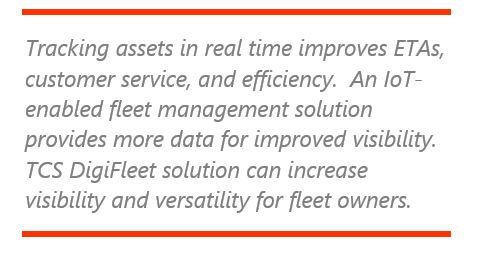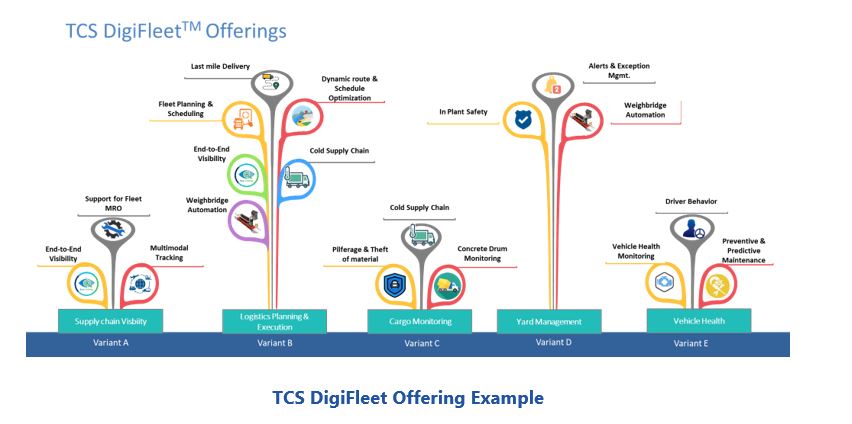

The ability to track fleet assets in real time is becoming increasingly important as companies look to provide more accurate estimated times of arrival to customers, drive efficiencies, and a 
Tata Consultancy Services (TCS) offers its TCS DigiFleet suite for IoT-enabled fleet management. Increasingly, industries rely upon effective transportation management practices to ensure on-time delivery with improved service levels and customer satisfaction. TCS designed TCS DigiFleet as a cloud-hosted, end-to-end smart logistics and transportation solution that features out-of-the-box offerings across multiple industries.
The global market for IoT applications continues to grow, with new use cases being developed constantly. Customer expectations drive the need for IoT-enabled solutions, which are currently underutilized within fleet management solutions. Today’s customer is looking for some core capabilities from a solution. First, it must be able to integrate with enterprise and supply chain applications. Second, it must be scalable. Third, it must have embedded analytics and use machine learning for scheduling and route optimization. Fourth, it must integrate with heterogeneous environments at the device level for vehicles with telematics devices and IoT sensors. And lastly, it must provide data privacy and security.
These customer expectations translate to a variety of fleet management capabilities. Specifically, when assets are the move, data must be used to optimize functional operations. This includes both fleet safety and route optimization. Often, customers have a difficult time understanding the data they are collecting from their assets. However, when combined with artificial intelligence, the right IoT application can help make sense of data to improve asset performance.
Using telematics, companies can track and provide real-time visibility into the locations of assets within the fleet. This enables them to communicate more accurate ETAs to their customers. Real-time tracking also enables better route planning. For example, if there are delays on the road, trucks can be re-routed and delivery times updated. This enables the customer to know whether they need to keep a dock door open or can have another delivery slide into that spot. This improved communication increases customer satisfaction and can reduce lost time at the warehouse.
An IoT-enabled fleet management solution can also help monitor driver behavior. Sensors within the truck can monitor dangerous driving behavior, such as harsh breaking or acceleration. The application can also monitor truck speeds. These data can be used to match drivers with appropriate deliveries. Other key capabilities for an IoT-enabled fleet management solution include schedule management, warehouse and yard management, cold chain monitoring, last-mile delivery, and in-plant safety management.
While the customer has certain expectations from an IoT-enabled fleet management solution, the “wants” are usually easier than the reality. For a solution to deliver, it needs to be fully scalable and integratable. Most companies that own fleets use a TMS for freight moves involving transportation assets owned by the company. The complete process would include routing and optimization, visibility, and exception management (including GPS-enabled solutions), transportation asset management, and performance management. The IoT platform required to enhance this solution needs to connect easily to the TMS so data can be pulled and used to improve performance. For those companies that do not have a TMS, the IoT solution must integrate seamlessly with the ERP system in use.
For an IoT-enabled fleet management solution, however, integration goes beyond the TMS or ERP. Customers need a solution that can easily integrate with sensors in the trucks for real-time asset monitoring and health maintenance. These sensors bring in all sorts of data about the truck, including driver safety information, temperature regulation for cold chain, and alerts for required maintenance on different aspects of the truck. The end-to-end integration is a requirement to enable end-to-end visibility of the company’s global logistics.
Monitoring fleet assets in real time is a complex endeavor, but one that can drive results. An IoT-enabled fleet management solution provides real-time visibility into asset location for better ETAs. Additionally, it gives real-time alerts on exceptions and violations. Machine learning and artificial intelligence improves route planning and execution and vehicle maintenance scheduling, and automates decision making. The result is better fleet tracking, reduced wait times at destinations, better vehicle utilization, and cost savings from proactive maintenance.
Tata Consultancy Services provides IT services, consulting, and business solutions. TCS DigiFleet is an IoT-enabled Suite focused on empowering customers with real-time actionable business insights on assets on-the-move globally and drive operational efficiency and cost reduction through AI/ML based predictive recommendations for ETA and vehicle health.
The suite is cloud- agnostic and offered on the solution-as-a-service (SaaS) model with GPS and telematics devices, IoT sensors, and communication networks.

Fleet management solutions can span multiple industries with unique use cases for each. As we learned, TCS DigiFleet is designed to provide industry versatility, mapping industries with both fleet management capabilities as well as integrated logistics capabilities. The core industries TCS DigiFleet serves include manufacturing; retail and CPG; utilities; travel & transport; energy & resources; and finance, banking, & insurance. Fleet management capabilities include EV management, driver behavior, commercial telematics insurance, airport ground handling, and mining operation management. The integrated logistics capabilities include unified supply chain visibility, vehicle & cargo tracking, dynamic route & scheduling management, warehouse & yard management, cold chain monitoring, last mile delivery, and in-plant safety management.
An IoT-enabled fleet management solution can improve visibility and versatility for companies across multiple industries. Versatility is important, as each industry has its own set of unique requirements across fleet management and integrated logistics. The use of an IoT-enabled fleet management solution can boost performance by improving asset visibility and vehicle utilization, reducing wait times at destinations, and providing proactive maintenance-related cost savings.
TCS DigiFleet is a trademark of Tata Consultancy Services Limited.
ARC Advisory Group clients can view the complete report at ARC Client Portal
If you would like to buy this report or obtain information about how to become a client, please Contact Us
Keywords: Fleet Management, IoT, Telematics, Asset Visibility, DigiFleet, TCS, ARC Advisory Group.

